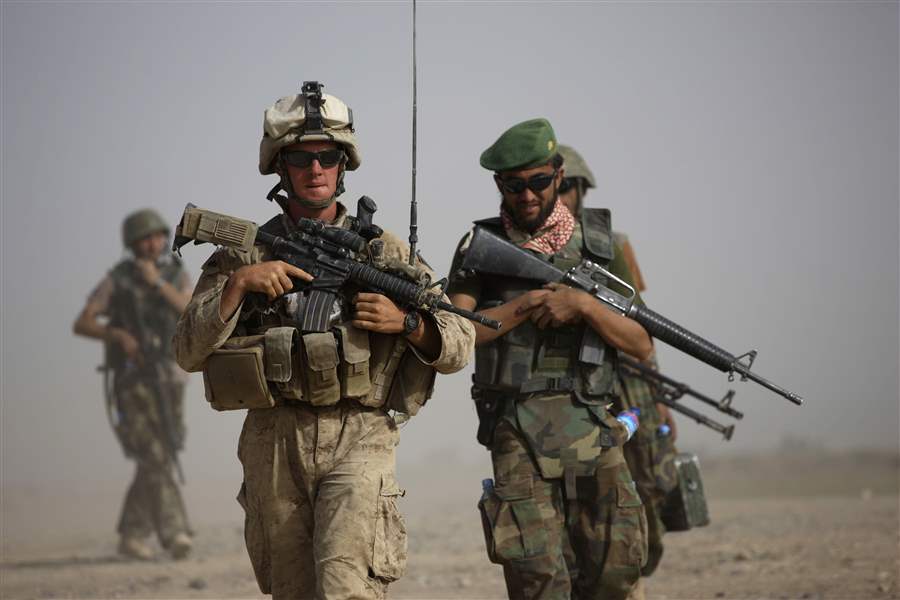
WAR IN AFGHANISTAN
U.S. soldier deaths hit 2,000 mark
Fear of insider attacksmay affect exit strategy
10/1/2012
U.S. Marine squad leader Sgt. Matthew Duquette, left, of Warrenville, Ill., with Bravo Company, 1st Battalion 5th Marines walks with Afghan National Army Lt. Hussein, during in a joint patrol in Nawa district, Helmand province, southern Afghanistan.
Associated Press

U.S. Marine squad leader Sgt. Matthew Duquette, left, of Warrenville, Ill., with Bravo Company, 1st Battalion 5th Marines walks with Afghan National Army Lt. Hussein, during in a joint patrol in Nawa district, Helmand province, southern Afghanistan.
KABUL, Afghanistan — Days after joint operations between U.S. and Afghan forces had returned to normal, five people — two Americans and three Afghans — were killed in a battle between soldiers of the two sides, U.S. and Afghan officials said Sunday.
The attack pushed U.S. military deaths in the war to 2,000, a cold reminder of the perils that remain in an 11-year conflict.
“The tally is modest by the standards of war historically, but every fatality is a tragedy and 11 years is too long,” said Michael O’Hanlon, a fellow at the Brookings Institution in Washington.
“All that is internalized, however, in an American public that has been watching this campaign for a long time. More newsworthy right now are the insider attacks and the sense of hopelessness they convey to many,” he said.
Attacks by Afghan soldiers or police — or insurgents disguised in their uniforms — have killed 52 American and other NATO troops this year.
“We have to get on top of this. It is a very serious threat to the campaign,” the U.S. military’s top officer, Army Gen. Martin Dempsey, said about the insider threat.
The top commander of U.S. and NATO forces in Afghanistan, Gen. John Allen, was blunter.
“I'm mad as hell about them, to be honest with you,” General Allen told CBS’ 60 Minutes in an interview broadcast on Sunday. “It reverberates everywhere across the United States.”
Insider attacks are considered one of the most serious threats to the U.S. exit strategy from the country.
Afghan officials said the clash on Saturday was a misunderstanding and that the Americans apparently attacked an Afghan National Army unit in error.
A top coalition officer said the Americans were attacked first in what might possibly have been an insurgent attack.
An initial statement from the NATO-led International Security Assistance Force on Sunday described the episode as “a suspected insider attack,” which killed a foreign soldier and a civilian contractor.
The episode clearly represents another in a series of setbacks in relations between the U.S. and Afghan militaries. It occurs at a delicate moment, when all of the U.S. surge reinforcements have only recently left the country and NATO has been trying to transfer ever greater responsibility to a growing Afghan military.
Shahidullah Shahid, the spokesman for the governor in Wardak province where the fighting occurred, said the deaths occurred “after a clash ensued between two sides following a misunderstanding.”
An Afghan official said on condition of anonymity that a mortar shell had landed amid the U.S. unit, killing a soldier and a civilian contractor and wounding several others.
The Americans thought it came from a nearby Afghan National Army checkpoint on a hill and attacked it with small arms and rockets, killing three and wounding three of the seven soldiers there, the official said.
The Wardak provincial police chief, Abdul Qayoum Baqizoi, said the fight broke out when an Afghan soldier among seven soldiers at the checkpoint opened fire on the Americans; in the ensuing gun battle, three Afghan soldiers were killed, including the one who fired first.
Significantly, according to Afghan officials, the U.S. unit, which was relatively small in size and manning a temporary checkpoint in the Sayid Abad District, was not partnered with Afghan forces.
The unit was conducting a biometric survey, in which details like fingerprints and eye scans are gathered from the local population, often at temporary checkpoints, in an effort to screen for insurgents.
Lt. Gen. Adrian Bradshaw of the NATO-led force read a brief statement on Sunday that did little to clarify what happened between the allied and Afghan soldiers.
“What was initially reported to have been a suspected insider attack is now understood to possibly have involved insurgent fire,” General Bradshaw said.
Asked if the restrictions on joint patrolling were a factor in Saturday’s clash, General Bradshaw did not respond to the question. He said instead that the restrictions were not a change in strategy but were prompted by increased caution about the reaction in a Muslim country to the incendiary video recently posted on YouTube that denigrated the Prophet Mohammed.